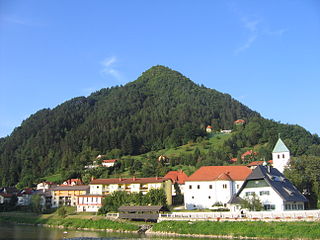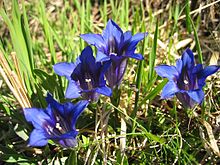
Gentiana is a genus of flowering plants belonging to the gentian family (Gentianaceae), the tribe Gentianeae, and the monophyletic subtribe Gentianinae. With about 400 species, it is considered a large genus. Gentians are notable for their mostly large trumpet-shaped flowers, which are often of an intense blue hue.

Gentiana acaulis, the stemless gentian, or trumpet gentian, is a species of flowering plant in the family Gentianaceae, native to central and southern Europe, from Spain east to the Balkans, growing especially in mountainous regions, such as the Alps and Pyrenees, at heights of 800–3,000 m (2,625–9,843 ft).

Charles de l'Écluse,L'Escluse, or Carolus Clusius, seigneur de Watènes, was an Artois doctor and pioneering botanist, perhaps the most influential of all 16th-century scientific horticulturists.

Gentiana lutea, the great yellow gentian, is a species of gentian native to the mountains of central and southern Europe.
Stemless gentian is a common name for several plants and may refer to:

The Malá Fatra National Park is a national park in the northern part of the Malá Fatra mountains called Krivánska Malá Fatra.

Gentiana nivalis, the snow gentian or Alpine gentian, is a species of the genus Gentiana. It grows to a height of 3–15 centimetres.

Gentiana andrewsii, the bottle gentian, closed gentian, or closed bottle gentian, is an herbaceous species of flowering plant in the gentian family Gentianaceae. Gentiana andrewsii is native to northeastern North America, from the Dakotas to the East Coast and through eastern Canada.

Gentiana alba is a herbaceous species of flowering plant in the Gentian family Gentianaceae, producing yellowish-white colored flowers from thick white taproots. It is native to North America from Manitoba through Ontario in the north, south to Oklahoma, Arkansas and North Carolina, and it is listed as rare, endangered, threatened or extirpated in parts of this range.

Hum, 583-metre (1,913 ft) high and the most prominent peak of the Laško region, is situated on the Savinja river's left bank. For ages, its foothills have been giving a shelter to the old castle under which thermal water has been pumped from the springs. There is a wide view from Hum on to Laško and its surroundings.

Gentiana villosa, the striped gentian, is a herbaceous perennial plant belonging to the genus Gentiana. It is found mainly in the Eastern United States and is used medicinally by Native American tribes.

Grays Peak National Recreation Trail or Grays Peak Trail lies along the Continental Divide of the Americas, part of the Rocky Mountains in the U.S. state of Colorado. It is located in the White River National Forest, Summit County. Grays Peak Trail is south of Interstate 70, east of Keystone Resort and near Montezuma. Grays Peak is adjacent to Torreys Peak. The Grays Peak Trail begins 3 miles above Interstate 70, at 11,200 feet. The summit of Grays Peak is 3.7 miles from the trailhead. Torreys Peak is 4.15 miles from the trailhead, across a saddle from Grays Peak. Grays Peak Trail ascends south through the wetland willows of Stevens Gulch. The trail passes between Stevens Mine on a lower slope of McClellan Mountain, 13,587 feet, forming the eastern wall of the valley, and Sterling Silver Group Mine beside the trail to the right on Kelso Mountain, 13,164 feet. The trail climbs 900 feet during the first 1.7 miles to a National Recreation Trail sign indicating that the summit is two miles farther.
Stenoptilia coprodactylus is a moth of the family Pterophoridae. It is found in Spain, France, Italy, Switzerland, Austria, Germany, Poland, the Czech Republic, Slovakia, Hungary, Romania, Bulgaria, Serbia and Montenegro, Bosnia and Herzegovina, Albania and Russia.
Stenoptilia graphodactyla is a moth of the family Pterophoridae. It is found in Spain, Belgium, Germany, Poland, the Czech Republic, Slovakia, Austria, Switzerland, Italy, Romania, Bulgaria, Serbia and Montenegro, North Macedonia and Albania. It is also known from Russia.

Gentiana cruciata, the star gentian or cross gentian, is a herbaceous perennial flowering plant in the Gentianaceae family.

Gentiana puberulenta, the downy gentian, is a branchless perennial plant of the Gentianaceae family native to North America. It is about ¾–1½' tall, with bright blue to deep blue-violet bell-shaped, upright, five-lobed flowers measuring 1½ to 2¼ inches across when fully open. Flowers grow in clusters of 1–8 at the apex of the plant. Lanceolate, sessile, glossy leaves up to 3" long and 1¼" across are arranged oppositely along the central stem, except at the apex where they grow in whorls of 3–7. Gentiana puberulenta grows in dry upland prairies and woods and rocky open slopes.

Gentiana pannonica, the Hungarian gentian or brown gentian, is a species of flowering plant of the genus Gentiana in the family of Gentianaceae.

Gentiana froelichii, commonly known as the Karawanken gentian, is an endemic hemicryptophyte and perennial plant species in the family Gentianaceae, which occurs in southeastern Alps. It can be found in Austria and Slovenia, with a few reported occurrences happening in Italy.















